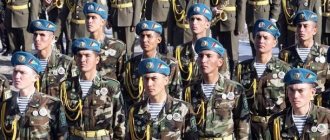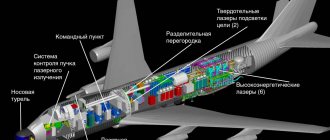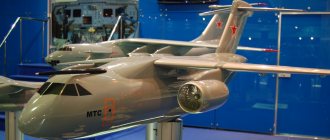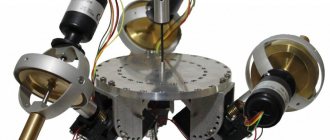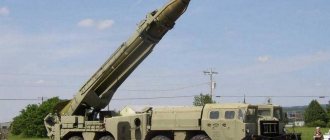How is that?
Modern anti-aircraft missile systems operate at very long distances, inaccessible to the human eye. For example, the S-200 air defense system, no longer used in the Russian army due to obsolescence, depending on the type of missile, could hit a target at a distance of up to 255 kilometers and an altitude of more than 40 kilometers. At such a distance, it’s simply impossible to even see the plane, let alone distinguish the identification marks on the fuselage.
How, then, does the determination of the target and its identification occur?
At what point does that “friend or foe” system work and how to distinguish a fighter from a civilian aircraft?
Launcher 5P72 S-200 air defense system in combat position (photo: Grigory Bedenko)
We will analyze everything using the example of the same S-200, so that later there will be no questions: “What about state secrets?” But you need to understand that in the new anti-aircraft missile systems everything is similar, only faster and more technologically advanced. Otherwise, it’s very close.
More and more drums
New tasks and new capabilities of weapons and military equipment place increasingly high demands on the training of personnel of military air defense units. However, things are traditionally going well with this.
On the eve of the New Year, an extended meeting of the Military Council of the Army was held in Moscow under the leadership of the Commander-in-Chief of the Ground Forces, Army General Oleg Salyukov. During the meeting, the results of troop training in the 2022 academic year were summed up and tasks for the 2020 year were determined. In particular, the commander-in-chief noted that more than 290 applicants were involved in the verification of military formations for the assignment of the honorary name “shock” - from company to brigade inclusive. The main part of the units confirmed their intentions, the military personnel showed excellent results in carrying out all measures to bring them to the highest levels of combat readiness, a high level of moral and psychological state and coherence, solid knowledge, skills and abilities during control exercises.
© mil.ru
An extended meeting of the Military Council of the Army was held in Moscow under the leadership of the Commander-in-Chief of the Ground Forces, Army General Oleg Salyukov.
Army General Oleg Salyukov noted that more than 50 military formations have applied for the designation “shock” from military air defense. This is 70 percent more than in the 2022 school year.
Numbers
- 1,5 a trillion rubles were allocated in 2022 from the state budget of the Russian Federation for the implementation of the state defense order;
- 68 percent of these funds were allocated for serial complete purchases of high-tech weapons and equipment;
- 60 percent, the level of provision of permanent readiness units of the Ground Forces with modern weapons and equipment has reached;
- 436 The main types of missile and artillery weapons, including those for military air defense, are planned to be delivered to the Ground Forces, coastal forces of the Navy and Airborne Forces in 2022.
Preparedness number one!
Let's start with the combat crew. For the S-200 complex it is 13 people - ten soldiers and three officers. Without so many people it is simply impossible to fight. And yes, all the most interesting things happen not in the cabins of the launchers, but in the cabin of the K-2 radio battery. There are: the firing officer, the launch officer, the guidance operator, the capture operator and the recorder, who is responsible for recording all significant moments of the battle or exercise.
Combat crew of the K-2 cockpit. The main functionaries: the shooter (standing in the picture), the launch officer, the guidance operator and the capture operator (photo: Anatoly Shmyrov)
The information from the remote control is photographed in order to later be able to determine how correctly the calculation was performed.
There’s not much room for four people in the K-2 cabin, but what can you do – this is war, there’s no time for comfort.
Next to the anti-aircraft missile system, in the most visible place, an observer from a visual observation post sits with binoculars in his hands. He turns his head like an owl, and must be the first to see whether an enemy tank has come out of the bushes, or whether a stray drone or enemy helicopter has broken through over the tops of the trees. The observer is the eyes and ears of the other rocket scientists, because they are sitting in the cockpit, very busy and will easily miss even a carnival passing by.
Cabin K-2 outside
The remaining fighters are at the starting battery. They are preparing the missiles for launch (for the S-200 it took several minutes - now, of course, it’s faster), and the diesel operator who is responsible for supplying electricity to the complex also sits there. After preparation, these soldiers will begin loading the next missiles onto launchers. During the launch, they hide either in the cockpit or in specially dug trenches.
Iron Dome: how missile defense systems work and why they can be deceived
Not all countries in the world have missile defense. Of course, there are corresponding installations in the USA, Russia and most EU countries, as well as in French Guiana, Morocco, Algeria, Israel, Saudi Arabia, Qatar, UAE, India, China and South Korea, Japan and New Caledonia. Major military players, such as the United States, sell their own developments to others. They supply South Korea and the UAE with their THAAD missiles. Aster missiles from the international European company MBDA are also used not only in Europe, but also in African countries. There is nothing exclusive about missile defense - systems in different countries operate on the same principle. Let's look at the example of the USA.
NATO and US missile defense system
The US National Missile Defense (NMD) system has been the subject of intense debate for much of the last century. This, given the political situation of the 20th century, was quite natural. In 1999, the US Congress decided that there was no more time for talk: it passed a bill to introduce a system to protect the country from the increasing number of foreign long-range missiles.
During the 2000 presidential campaign, George W. Bush. made it clear that his administration supports the missile defense program, despite the fact that its introduction affects relations between Russia and the United States. The Kremlin, in turn, opposed the creation of an American missile shield, but in the end the protective system was created. They spent $30.2 billion on it, five years of work, and finally put it into operation in 2005.
The system is still developing and improving, but is based on the model that was proposed during the time of President Reagan. There are no lasers or rapid-fire weapons, although early versions of the Strategic Defense Initiative (SDI) considered them as possible tools. Then the media dubbed the program a “Star Wars” system.
Modern US missile defense (GMD) uses some of the developments of the “fantastic” SDI, although the most “mundane” ones. The warheads are tracked by satellite and radar during the mid-flight phase, when the ICBM moves above the atmosphere at 20 times the speed of sound. GMD missiles launched from silos in Alaska and California shoot down ICBMs in the sky before they accelerate towards the ground, when any explosion would cause damage. GMD inherited several parts from SDI:
- Upgraded Ground Early Warning Radar (UEWR). This part of the system detects enemy missile launches and tracks their flight. Radar consists of a phased array that can detect and track ballistic missiles. The devices are located on ships and ground stations. The data collected by radars and satellites is sent to the BMC3 command post in Cheyenne Mountain, Colorado. There, in turn, they formulate ways to respond.
Phased array antenna is an antenna array, the direction of radiation and the shape of the corresponding radiation pattern of which are regulated by changing the amplitude-phase distribution of currents or excitation fields on the radiating elements.
A phased array differs in that the amplitude-phase distribution is not fixed, it can be adjusted (changed in a controlled manner) during operation.
- Space Based Infrared System (SBIRS). There are three types of SBIRS satellites: four geostationary Earth orbit (GEO) satellites, two highly elliptical orbit (HEO) satellites, and multiple low-Earth orbit (LEO) satellites. The US Army is currently working on the development of SEWS, a new satellite-based missile defense system. It will be able to detect missiles 20 seconds after launch, unlike SBIRS, which takes 40–50 seconds to detect.
- Ground-based X-band radar (XBR). The operation of this radar is also based on phased array and radar signal processing technology. XBR tracks missiles as they approach the United States and also assesses the threat of the projectiles. The system receives information about whether the missiles are equipped with warheads. The XBR is equipped with high-resolution radar to accurately detect nearby objects. The radar resolution is 50° and can rotate 360° to track targets. The system coverage is 17.46 acres (almost 71 thousand sq. m). It transmits the radiation pattern with a narrow beam of electromagnetic pulses. The radar station consists of an X-band radar mounted on a special pedestal, control and maintenance facilities, and power generation facilities. All this is located in a protected area of 150 square meters. m.
- Ground Based Interceptors (GBIs). The basis of modern missile defense is the technology of exoatmospheric destruction of devices (EKV). It includes sensors and engines that allow you to destroy enemy missiles without a ballistic charge. Interceptors use their own infrared seekers, guidance system and engine. As the missile approaches its target, X-band radar data is combined with information from onboard sensors to better detect the enemy missile. The EKV constantly adjusts the flight path until the missile reaches the final point of its path - at the skin of the launched projectile. The impact destroys the warhead and the charge in it - nuclear, chemical or biological.
X-band is a frequency range of centimeter wavelengths used for terrestrial and satellite radio communications. By IEEE definition, this range extends from 8 to 12 GHz of the electromagnetic spectrum (wavelengths from 3.75 to 2.5 cm), although in satellite communications this range is "shifted" towards the C-band and lies approximately between 7 and 10. 7 GHz.
All NATO countries have other systems for intercepting short- and medium-range missiles: the old Patriot models, the American-Israeli Arrow and the modern Iron Dome. These systems operate in a similar manner to the radar tracking method, but are only needed to intercept smaller missiles that have a significantly lower altitude and speed than an ICBM. Short- and medium-range systems cover areas of several tens of kilometers, so they usually serve as a backup resource for larger systems. Such installations are located on the borders of South Korea and Japan, from where they are close to the territories of Russia, China and the DPRK.
In addition, the bloc and the United States are armed with the Terminal High Altitude Area Defense (THAAD) system, which uses kinetic interception to accurately destroy enemy missiles. It works for medium-range projectiles and reaches them with a direct hit in the upper atmosphere.
Kinetic interception works in such a way that the enemy missile is either completely destroyed or continues its flight towards the target. The collision between the warheads leaves virtually no fragments that could damage or interfere with satellites. This method is called kinetic because the anti-missile does not carry a live projectile—the enemy target is shot down only thanks to the kinetic energy of the missile’s hardware compartment.
However, missile defense has a major disadvantage. George N. Lewis, a physicist and senior fellow at the Institute for Peace and Conflict Research at Cornell University, explains in his article “The Effectiveness of Ballistic Missile Defenses” that in real life, outside of testing, there is simply no experience launching interceptor missiles. The systems are tested and show themselves successfully in tests, but most experiments represent a demonstration of a large number of scenarios. As a result, the reliability of the systems themselves is shown rather than their actual effectiveness in real developments.
According to test evidence, the GMD system, which protects the entire NATO alliance,
only in 50% of cases. The newer Aegis system shows better results, working both day and night. However, its anti-missile missiles have too low a speed, which is not enough to cover large areas. It can be used to protect cities, small countries, but not continents.
Even if the likelihood of successful use of GMD and Aegis increases, this will still not be enough. For example, if the probability is 80-90%, the remaining 10-20% will continue to be the main criticism of the current American systems.
In addition, experiments often do not take into account the use of “countermeasures” by the attacking party. They include various mechanisms, such as distracting beacons or cooling panels to distract or confuse radars. The American GMD system is good at tracking missile launches, but it does not understand at all whether these missiles are loaded with charges. The main sensor responsible for recognizing charged missiles is located in Honolulu and has great operational limitations. And although there are suggestions that “countermeasures” greatly reduce the effectiveness of missiles, this does not solve the problem itself.
How to deceive a missile defense system?
One of the challenges for any missile defense system is the countermeasures that an adversary may take. There are many different tricks, and many of them interfere with the operation of the radars, reducing the usefulness of the system to nothing.
An ICBM that enters an intermediate phase above the atmosphere can launch decoys to distract interceptors. They follow the same trajectory as a real ICBM, making it difficult to track a real warhead with a charge. The only way to avoid disaster is to shoot down all enemy objects. For the United States, which has only 44 interceptor missiles capable of destroying ICBMs, this could be a fatal mistake. The enemy is quite capable of launching the 45th missile with a charge.
The "cooled jacket," the outer skin of the missile, can reduce the temperature of the warhead. Interceptors rely on infrared sensors to track targets, making a cold missile much more difficult to see. Such countermeasures are in service with Russia, Iran and North Korea, which pose the main danger to the United States.
One of the latest developments in rocket science is hypersonic warheads. Now they are being tested in parallel by China, Russia, Japan and the United States. Such weapons combine the speed of a ballistic missile with the maneuverability of cruise missiles. The projectiles move at a speed of 6,115.5 km/h and can maneuver throughout the entire flight. In essence, such a warhead simply evades missile defense missiles flying at it. A hypersonic missile is by far the most effective method against modern missile defenses.
The hypersonic missile develops enormous speed thanks to a jet engine that uses “air breathing” technology. The engine collects oxygen from the atmosphere and mixes it with hydrogen fuel, creating the combustion needed for ultra-fast travel. At the same time, the method differs from the one usually used when launching space shuttles: there the combustion process occurs thanks to liquid oxygen, an oxidizing agent, which already makes up 70% of space fuel.
Hypersonic missiles are launched in two ways: first, they are released during the final stages of an ICBM's takeoff, flying at the top of the atmosphere and accelerated by jet engines; secondly, they, like cruise missiles, can be fired from a bomber.
The main danger of hypersonic missiles for missile defense is that they are able to maneuver in flight, and therefore evade interceptor missiles. There are few options for combating hypersonic warheads: fire all standard anti-missiles at once, closing most of the space for maneuver, or deploy maneuvering high-speed homing elements against the enemy missile. Such a projectile flying towards the warhead will release its destructive elements, again blocking the maneuver trajectories.
When talking about the speed of a rocket that flies faster than the speed of sound, they prefer to use the Mach number - this is the real speed in a certain medium that is filled with matter. For example, the speed at which air flows around, for example, an airplane. To obtain the speed in Mach numbers, you need to divide this speed of a substance by the speed of sound in this substance. The higher the altitude, the lower the speed of sound and the higher the Mach number.
If US President Ronald Reagan had insisted on homing lasers, there would have been no problems with hypersonic missiles. However, this would be a wonderful invention in the truest sense of the word. Tests at the Kazakh Sary-Shagan test site showed that the power of Soviet lasers was not enough to destroy a ballistic missile warhead. The test conclusions are also valid for the United States: the energy of American lasers did not exceed several kilojoules. By 1975, the USSR had installations with a capacity of 90 kJ.
Russia has a plan to solve the problem of hypersonic warheads. Long-range interception missile systems are being developed for the MiG-31 and MiG-41 fighters, which are capable of hitting hypersonic ammunition. They work like this: a heavy missile is fired from an aircraft and delivers several advanced air-to-air missiles to the hypersonic projectile's flight area. The missiles are then separated from the carrier and attack targets independently thanks to a homing head.
But there is a lot of criticism of this technology. Firstly, its application to conventional ballistic missiles also raises doubts. Secondly, Russian MiG-based hypersonic defense will operate against tactical hypersonic missiles, not ICBMs. Current American and Russian hypersonic missiles reach speeds of Mach 8 to 10. In this case, ICBM warheads fly above the atmosphere at higher speeds, but are not able to change their trajectory. It's hard to imagine that an object traveling at ten times the speed of sound would leave time to detect and react.
To battle!
Initially, it is not the anti-aircraft missile system itself that detects the intruder. They try not to turn on the equipment again, so as not to “highlight” such a tasty target for the enemy. The radar station operators inform the regiment commander about the detection of an intruder, and only then does he give the order to bring the anti-aircraft missile system number one to readiness. As soon as this order comes, all the equipment begins to turn on, and the diesel operator runs to start the diesel engine.
S-200 SAM target illumination radar
If the S-200s were located in populated areas, they were powered from a regular electrical network. But under the order “readiness number one”, the rules require switching to your own power source. You never know.
It is at this time that the homing heads are prepared, the indicators behind which the operators sit are turned on and checked, and so on, so on, so on. At the same time, the air defense system makes a lot of noise: the diesel engine roars, the radio battery starts working on a shrill note, and the clicks of the altimeter are heard.
At this time, all the indicators in the cabin are already turned on and working. First of all, the calculation monitors the functioning of the equipment - this is a check of all systems in a simplified form to make sure that they are normal. It happens that preparation for combat is carried out according to the accelerated readiness option, then the functioning of the equipment is not monitored.
Time is more important.
After carrying out the control, the soldiers make a report: “The third is in readiness number one, on four channels, the equipment is in working order, the functioning control has been carried out.” About six minutes pass from the moment the order is received until the report is made.
"Sea Soul" of an Infantry Recruit
...An attack drone emerging from low-hanging clouds sets fire to the first combat vehicle, and the second to the trailing one. A barrage of fire falls on a frozen column of armored vehicles. Enemy helicopters shoot at a unit that has lost mobility from a safe height and distance. Return fire with standard weapons of infantry fighting vehicles and armored personnel carriers is useless...
© mil.ru SAM "Gibka-S" on the march.
Such a scenario in modern warfare may become typical, standard for the destruction of military columns advancing to their destination. Try to attack motorized riflemen, tankers, and artillerymen from the air in places of deployment or in equipped strongholds: everywhere attacking aircraft will be met with fire by the forces and means of military air defense. “The weak link” is the marches. And, according to military theorists, there can be a lot of them in a modern highly maneuverable war. It is too wasteful and expensive to send the excellent Tor complex to accompany each battalion or individual company due to the high cost of its high-precision missiles. The Pantsir anti-aircraft missile and gun system (ZRPK) is now “taught” by designers to fire on the move, but it “works” better from equipped positions.
To solve the pressing problem of covering units and subunits of the Ground Forces, it was decided to “dry land” the successful “fly swatter” of the Navy. Developed by specialists from the Altair Naval Research Institute of Radio Electronics, part of the Almaz-Antey air defense concern, the 3M-47 air defense system has proven itself to be excellent in the navy. The Gibka guided weapon system is installed, for example, on the small artillery ships Astrakhan and Volgodonsk, and on the large anti-submarine ship Vice Admiral Kulakov.
© wikimedia.org
3M-47 "Gibka" air defense system on the large anti-submarine ship "Vice Admiral Kulakov".
Now it has been decided to use it as part of military air defense on the ground.
Reference
Air Defense Forces (Air Defense Forces) are a branch of the Ground Forces, designed to cover troops and objects from the actions of enemy air attacks when combined arms formations and formations conduct operations (combat operations), perform regroupings (march) and are positioned on the spot.
Today, air defense systems are capable of destroying enemy air attack weapons in the entire range of altitudes: extremely low - up to 200 m, low - from 200 to 1000 m, medium - from 1,000 to 4,000 m, high - from 4,000 to 12,000 m and in the stratosphere - more than 12,000 m.
The Russian air defense forces are armed with modern S-300V4, Buk-MZ, Tor-M2, Pantsir-S and others. In 2022, the share of modern equipment in military air defense should increase to 70 percent.
Assignment for tomorrow
Ten new types of weapons are being created for military air defense. This was announced in December 2019 in an interview with the newspaper of the Armed Forces of the Russian Federation “Red Star” by the head of the Air Defense Forces, Lieutenant General Alexander Leonov. He noted that in 2022 it is planned to complete state tests of the Adjutant target system, on the chassis of which targets are placed that simulate all modern air attack weapons, including cruise missiles, airplanes and helicopters.
Among the development work carried out by enterprises of the military-industrial complex on behalf of the Ministry of Defense is the development of a promising mobile anti-aircraft artillery system (ZAK) with a 57-mm high-ballistic automatic cannon “Derivation-PVO”. This complex is designed to combat mini- and micro-drones and should replace the Shilka anti-aircraft installation.
Air Defense Forces Day
Air Defense Day was introduced in the USSR on February 20, 1975, as a special holiday for military personnel who were involved in the country's air defense. Then Air Defense Day was celebrated on April 11. Since 1980, Air Defense Day in the USSR began to be celebrated every second Sunday in April.
In 2006, by a special Decree of the President of the Russian Federation of May 31, Air Defense Day was officially declared a memorable day. The holiday is also celebrated every second Sunday in April.
Air defense troops during World War II
World War II demonstrated how important aviation was. The ability to launch rapid air strikes has become one of the keys to the success of military operations. The state of the USSR air defense before the start of the Second World War was far from perfect and was completely unsuitable for repelling massive raids by German aviation. Although before the start of the Second World War the Soviet command devoted a lot of time and money to the development of air defense systems, these troops turned out to be completely unprepared to repel modern German aircraft.
The entire first half of the Second World War was characterized by huge losses of Soviet troops precisely because of enemy air raids. The USSR ground forces did not have the necessary air defense system at all. The defense of the corps from air attacks was carried out by a regular number of air defense weapons, which were represented along 1 km of the front by the following fire weapons:
- 2 anti-aircraft guns;
- 1 heavy machine gun;
- 3 anti-aircraft quad installations.
In addition to the fact that these guns were clearly not enough, there was a huge need for fighter aircraft at the front. The air surveillance, warning and communications system was in its infancy and was completely unable to cope with the tasks assigned to them. For a long time, the troops did not even have their own means of this type. To carry out these functions, it was planned to strengthen the armies with VNOS radio companies. These companies were completely at odds with the technical development of German aviation, since they could only detect enemy aircraft visually. Such detection was possible only at a distance of 10-12 km, and modern German aircraft covered a similar distance in 1-2 minutes.
Before the start of the Second World War, the domestic theory of the development of air defense troops did not place any serious emphasis on the development of this group of troops. Based on the dogmas of this theory, air defense troops, no matter how highly developed they are, are not able to provide complete protection of the front from enemy air raids. In any case, small enemy groups will still be able to reach and destroy the target. That is why the USSR command did not pay serious attention to air defense troops, and the construction of air defense was based on the fact that air defense systems would distract the enemy, allowing aviation to enter the battle.
In any case, the fighter aviation of the USSR in the first years of the war was not able to give any serious rebuff to enemy aircraft, which is why German pilots in those years organized a real entertaining “hunt” for ground targets.
Realizing their mistakes, the Soviet command concentrated its efforts on developing air defense systems, placing special emphasis on improving fighter aircraft and anti-aircraft artillery.
The history of the appearance of air defense troops in Russia
The need for anti-aircraft artillery was realized at the end of the 19th century. In 1891, the first firing at aerial targets took place, using balloons and aerostats. The artillery showed that it could quite successfully cope with stationary air targets, although shooting at moving targets was unsuccessful.
In 1908-1909, experimental firing at moving targets took place, as a result of which it was decided that in order to successfully combat aviation, it was necessary to create a special gun designed for firing at moving air targets.
In 1914, the Putilov plant produced four 76 mm cannons, which were intended to combat enemy aircraft. These guns were transported on special trucks. Despite this, before the outbreak of the First World War, Russia turned out to be completely unprepared for combat with an air enemy. Already in the fall of 1914, the command had to urgently form special artillery units, the main task of which was to fight enemy aircraft.
In the USSR, the first air defense units, consisting of searchlight companies and machine gun installations, first took part in a military parade on May 1, 1929. By the 1930 parade, the air defense troops were replenished with anti-aircraft artillery, which was transported in cars:
- 76 mm anti-aircraft guns;
- Machine gun installations;
- Floodlight installations;
- Sound detection installations.
